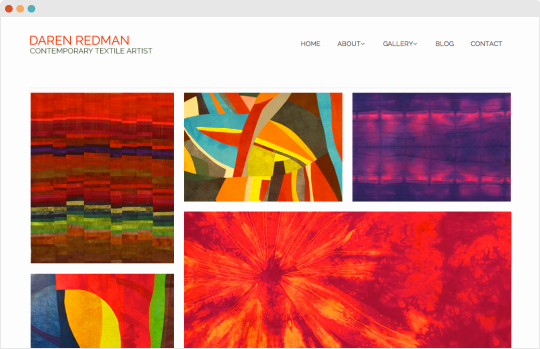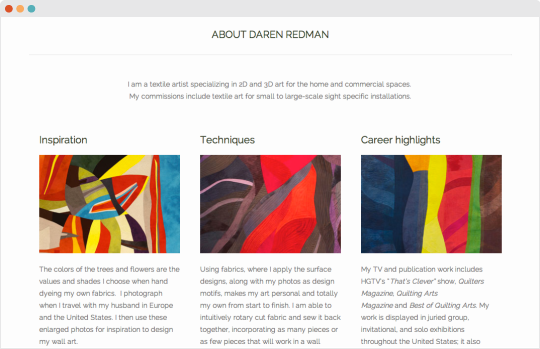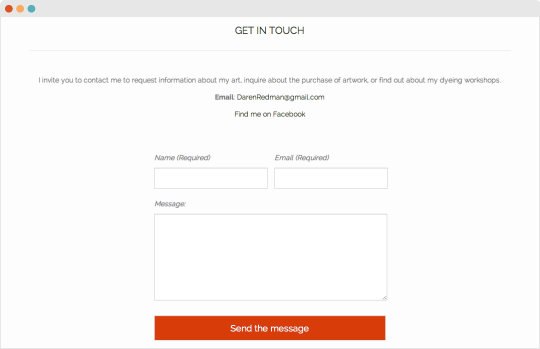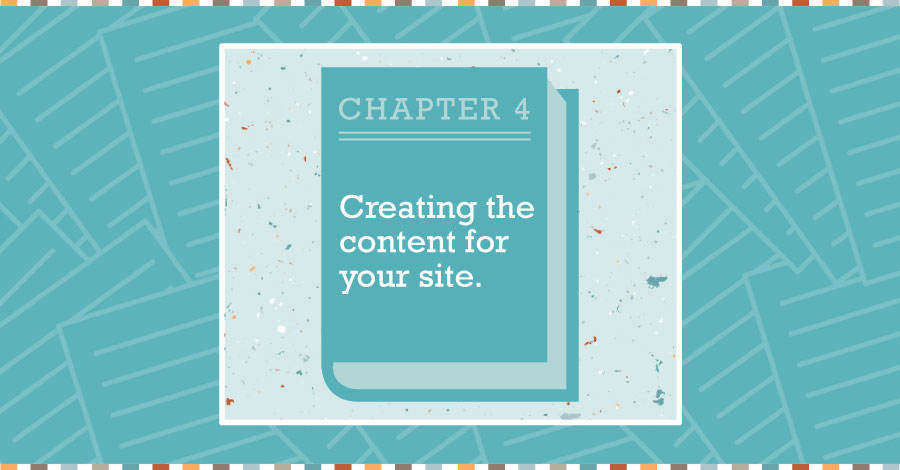The art of writing about art
By the end of this tutorial, you’ll have the tools to create great content for your website pages. We’ll explore some general guidelines for writing engaging copy about art and get into the specifics of how to select images and develop text for your individual pages, such as your home page, gallery pages and an artist biography.
The easiest way to keep your written content focused is by asking, ‘Is this helping to achieve my objectives?’ In other words, does it fit in with your mission statement? It is also extremely useful to imagine you are talking directly to one person (the person you created in your Ideal Visitor Profile). This will help you seem personable, approachable and engaging, and will give your writing an easy, unforced style.
General rules for creating compelling content for your artist website
[ezcol_1half]
Be a storyteller
People love stories, so see if you can use time, place, characters, conflict and resolution to engage your visitors. Your life as an artist will already be full of stories; don’t be afraid to use them cleverly and concisely.
Be natural
Try to avoid long, complicated or little-known words as this will alienate some visitors. Write as you speak – like a human being! Use simple, concise language to convey your ideas, no matter how big they are.
Avoid or explain jargon
It’s tempting, as an artist in a specific field, to assume everyone knows what ‘encaustic’ is or what ‘worsted yarns’ are; it’s better to assume these words may need some explanation.
Write as yourself
Use the first person wherever possible to encourage readers to engage with you on a personal level.
Be concise
Keep the text on each page short. Remember, to an extent, the artwork should speak for itself. Therefore aim not to go beyond 300 words per page. On a visually-led site, the text is secondary. You can include a ‘Read more’ link to a more detailed page (that doesn’t appear in your main navigation) for those people who are interested in learning more about you, but in general the main pages of your site shouldn’t be text-heavy.
[/ezcol_1half] [ezcol_1half_end]
Get to the point
The most important content should be in the first paragraph of any page on your site. This will engage readers with the main idea straight away.
Edit
To write clear, concise content, keep your paragraphs short and eliminate unnecessary words or phrases.
Use headings
Headings will help divide your written content into manageable chunks. Under each heading, aim to cover one topic only.
Use lists
Lists are a great way of breaking a page up so that it doesn’t seem overwhelming. They also allow readers to easily scan the content.
Keep it active
Use the active voice to give your writing forward momentum and energy. (‘I use the sewing machine to stitch an outline’ rather than ‘The sewing machine is used to stitch an outline’).
What do you want the reader to do next?
Visitors like to be led, so at the end of each page include a Call to Action. It could be a simple link to the next page, or you may invite them to sign up for your newsletter or follow you on Twitter.
[/ezcol_1half_end]
Writing about your artwork for specific pages on your site
Homepage
[ezcol_1half]
The home page of your site is normally the front page or landing page. For an artist website the homepage should be visually engaging. Select artwork that you know resonates with people straight away. You will no doubt have feedback from exhibitions to draw upon; which of your pieces has consistently captured the imagination of viewers? Which piece will intrigue visitors enough that they want to see more or know more about it? Go back to your mission statement; which pieces of work are most likely to help you achieve your objectives? Using one large striking image can be effective or you may opt for a slider or collage of 4 or 5 of your favourite pieces as we did when building DarenRedman.com.
[/ezcol_1half] [ezcol_1half_end]

[/ezcol_1half_end]
In terms of text, consider using a subtitle under the main heading of your page. It should be short and punchy and sum you up as an artist in a few words (Daren Redman – Contemporary textile artist).
You may want to include a paragraph on the homepage as a snapshot of information about you as an artist. Keep it short and use it to capture the attention of the visitor. It should tell us who you are and what makes you different (do you use an unusual technique or find inspiration from a strange and intriguing source?).
It is also effective to include a Call to Action on your homepage. Again, refer to your mission statement and use the Call to Action to achieve your objectives. If you wish to sell art via your site, the Call to Action might invite visitors to visit your Gallery or Shop page. If the aim is to invite commissions, you might want to direct visitors to a specific sub-gallery of pieces created specifically for individual clients.
Visit Daren Redman’s homepage for an example.
About
[ezcol_1half]
This is your chance to tell visitors more about yourself. Write in the first person and think about talking directly to your ideal target visitor in exactly the same way as you would face-to-face at an exhibition.
Start with a general overview, which might include your training, selected exhibitions, prizes, and features in books or magazines. Don’t be tempted to list every single achievement here. Again, if you want to include a link to a sub-page with a full CV, visitors have the choice to find out more, but aren’t bombarded with information (this can be a real turn-off and send potential fans away very quickly).
[/ezcol_1half] [ezcol_1half_end]

[/ezcol_1half_end]
[ezcol_1half]
From there, you may want to use separate paragraphs to discuss:
- Why you’re an artist
- Materials you use
- Techniques you use
- Influences and inspiration
- Your vision
The series of interviews on TextileArtist.org has proved extremely popular; people love to know about how you discovered your talent and how it has developed.
[/ezcol_1half] [ezcol_1half_end]
Focus on anything that makes you different or unique and forget the rest for now. The topics you choose to discuss should work towards fulfilling your website objectives in some way.
Assume that visitors to your site know nothing about you. Furthermore, I would advocate writing as though they know nothing about art in general. Keep it simple.
You may also want to include an image of yourself at work on this page. This will help visitors get to know you.
Visit Daren Redman’s About page for an example.
[/ezcol_1half_end]
Contact
[ezcol_1half]
The Contact page should include a very brief, friendly message inviting visitors to get in touch. You can use this paragraph to work towards your mission statement too. If one of your objectives is to engage a community of loyal followers, include links to your Facebook page or a sign-up form for your newsletter.
Contact forms requiring visitors to enter their name and email address can look professional and are easily implemented on your site via WordPress (the platform we recommend). However, if you choose to include a contact form, I would advise that you also list all the pertinent contact information so that you seem trustworthy and transparent (Email address, as well as social media links like FaceBook, Twitter, LinkedIn, Google+, Pinterest).
[/ezcol_1half] [ezcol_1half_end]

[/ezcol_1half_end]
Your Gallery page
[ezcol_1half]
This is your chance to show a range of your work and perhaps the most important page on any artist website.
Selecting images
If you have a large body of work, don’t be tempted to include every single piece on your site. The Gallery will feel crowded and overwhelm visitors; leave them wanting more. Select the pieces you are most proud of and those which have proved popular.
Make sure the work you choose is well represented and expertly photographed. For tips on taking great digital images of textile art click here.
Organising the Gallery
You may want to divide your Gallery into sections (sub-galleries). This works well for artists who use multiple techniques or work in a variety of media, and helps visitors to navigate and make sense of the images and is a particularly useful tactic if you do decide to include a lot of work. For example, you may want sections entitled Wall hangings, Sculptures and Prints.
You can use the organisation of your Gallery as a means of working towards your mission statement too. If your objective is to attract Galleries to show your work, you may want to include a section entitled ‘Selected past works’ or something similar. Here you can showcase work that has won prizes or has been exhibited publicly at respected institutions.
[/ezcol_1half] [ezcol_1half_end]
Writing text for the Gallery page
Many artists have little or no text at all on their Gallery pages. I think this is a mistake. You need to give potential buyers reasons to engage with your art. You can do this by telling stories about the work. These should be concise but insightful. The more a viewer understands a piece, the more likely it is to resonate with them.
If your Gallery is divided into separate collections, give each section a one-paragraph explanation; explain why you made the artwork in that particular section and how. For each individual piece, it is customary and advisable to include a caption with the title of the piece, the year it was created, and the dimensions of the piece. I would also advise giving each piece a short individual description. What inspired the piece? How did you make it? (Materials and techniques). Again, the more the reader knows, the more likely the work is to speak to them.
Pricing your work
You may also want to add a price to each piece of work (if you are represented by a gallery, check with them first). Potential buyers often appreciate the up-front approach and can be reluctant to contact artists for prices for fear of being given the hard sell or suffering embarrassment if they can’t afford to follow through with the sale. Stating the price is more buyer-friendly and more likely to result in an eventual sale. You might also want to include a link reading ‘Make an enquiry about this piece’ or something similar which leads visitors to a contact page.
[/ezcol_1half_end]
More optional pages
Artist Statement
Instead of an About page you may prefer to have an Artist Statement. Of course it is perfectly acceptable to have both, but make sure they are telling visitors different things; there’s no point in repeating information. The statement should further develop the story of the homepage and tell the reader specifically about your process and vision.
If you use the About page to tell us about your personal journey into art, use the Artist Statement to explore the work itself more rigorously. Remember, writing a good artist statement, means keeping it free of esoteric and discipline-specific language, so that everyday mortals can understand it!
Biography/CV
If you have a long list of achievements, the most reader-friendly way to display them without overwhelming a reader with large chunks of text, is in a CV/Resume. You may want to include your training, experience working in the arts, awards, exhibitions and grants.
Press
If you have had positive press attention, use this page to archive it. This helps to provide a history of you and your work. Don’t be tempted to include the full text of a group show in which one sentence refers to you or your work. Use quotes and link out to the full article. A Press page is only a good idea if you have notable reviews from established, well-respected publications.
OK – so now you have all of the text for your artist website written and ready to go, it’s time to put it all together with images, so that everything that will make up your website is in one, easy, accessible folder on your computer.
![]()











